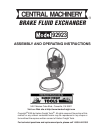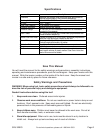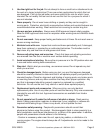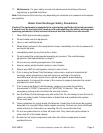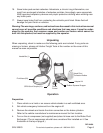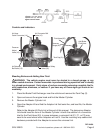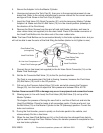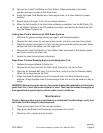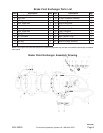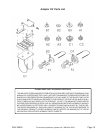Page 4
SKU 92923 For technical questions, please call 1-800-444-3353
17. Maintenance. For your safety, service and maintenance should be performed
regularly by a qualified technician.
Note: Performance of this tool may vary depending on variations in air pressure and compres-
sor capability.
Brake Fluid Exchanger Safety Precautions
Caution: This equipment is designed to be operated by qualified and trained personnel.
It should only be operated after reading and understanding the safety warnings and
operating procedures in this instruction manual and the vehicle’s service manual.
1. Wear ANSI approved safety goggles.
2. Do not smoke near this equipment.
3. Use in a well ventilated area.
4. When leaks are found in the equipment or hoses, immediately turn the air pressure off
and repair the leaks.
5. Immediately clean up any fluid spills or leaks.
6. Do not exceed the recommended operating air pressure. This could damage
equipment. See Specifications on page 2.
7. Do not use any cleaning compounds in this system.
8. Keep an empty plastic bucket nearby in case of leaks.
9. Keep a type ABC fire extinguisher nearby in case of fires.
10. Prior to using the Brake Fluid Exchanger make sure to read and understand all
warnings, safety precautions, and instructions as outlined in the vehicle
manufacturer’s service manual. Every vehicle has specific brake bleeding
requirements. It is beyond the scope of this manual to properly describe the correct
procedure for each vehicle.
11. Prior to using the Brake Fluid Exchanger, make sure to place the vehicle’s
transmission in “PARK” (if automatic) or “NEUTRAL” (if manual). Then, set the
emergency parking brake and block the tires with chocks.
12. Use the Brake Fluid Exchanger only with brake fluid. Do not attempt to use the tool to
siphon any other liquids. Contamination of brake fluid and possible brake system
failure may result.
13. Follow guidelines for proper brake fluid disposal. Used brake fluid should be properly
disposed of or recycled. Many states require recycling. Contact your local solid/liquid
waste authority for information on recycling. Do not reuse old brake fluid.
14. Do not use pressurized air to blow off brake dust. Only use brake parts cleaner to
clean dust off of the brake calipers.
15. Be alert for hot brake components and other hot vehicle components to avoid
accidental burns.



